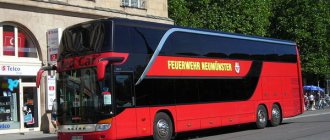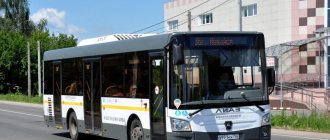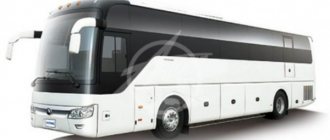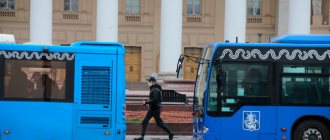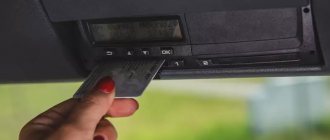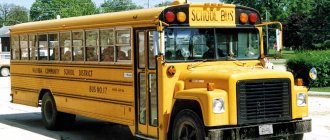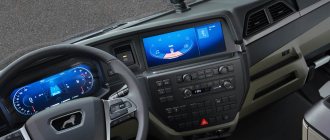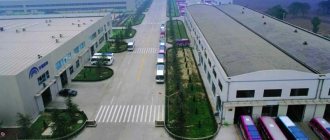Full description
The school modification PAZ 32053-70 fully complies with GOST R 51160-98 “Buses for transporting children. Technical requirements". The buses are designed for 22 seats, incl. 2 for accompanying adults, and an additional step will help even the smallest passengers climb onto the bus. In the interior of each car there are emergency communication buttons with the driver, and the driver’s workplace is equipped with external and internal loudspeaker installations. The bus is equipped with special seats with seat belts. The bus has a rack for backpacks. Special devices prevent movement when the doors are open and limit the speed to no more than 60 km/h. According to the latest changes to the above GOST, all buses for transporting children are equipped with electrically heated rear-view mirrors and a sound signal when reversing. Northern version: double glazing of side windows and insulation of the passenger compartment. From the fourth quarter of 2011, the bus will be equipped with engines that meet EURO-4 environmental standards, including YaMZ-534. A bus with a diesel engine is equipped with an engine brake as standard.
Advantages of PAZ 32053-70:
- Improved consumer characteristics;
- High degree of safety for passengers;
- High maintainability;
- Availability of spare parts;
- Suspension reliability on roads with any surface.
Guarantee period:
- with a diesel engine - 18 months or 50 thousand km.
- with a gasoline engine - 2 years or 60 thousand km.
Technical characteristics of PAZ 32053-70
| Body type | Load-bearing, all-metal, carriage-type |
| Wheel formula | 4x2 |
| Body resource | 5 |
| Length Width Height | 7000/2530/ 2940 |
| Ceiling height in the cabin, mm | 1965 |
| Base, mm | 3600 |
| Number/width of doors | 1/726+1 emergency |
| Min. turning radius, m | 7,6 |
| Curb/full weight, kg | 5080…6030/6270..7220 |
| Load on front/rear axle, kg | 2740…3260/3510…3980 |
| Total number of seats (including landing seats) | 22(22) |
| Fuel tank capacity, l | 105 |
| Chassis, bridge | KAAZ or RZAA |
| Steering gear | Power steering |
| Brake system | Pneumatic, dual-circuit, drive with axial division into circuits, with ABS |
| Ventilation | natural |
| Heating system | Calorifier from the engine cooling system |
| Tires | 8.25R20'' (240R508) |
School educational program (school bus)
Is it difficult to operate a school bus in a single high school? But the numerous problems that educational institutions faced after the distribution of machines as part of the “national education project” made us seriously interested in this topic. Moreover, we became aware of new methods of operating school buses in the Kaluga region.INVENTING THE SCHOOL BIKE Of course, nothing revolutionary new was invented in Kaluga. They simply quickly noticed that distributing buses to schools was fundamentally wrong. On the ground, problems arise immediately: where in a remote village can one find a driver with at least 3 years of bus driving experience, as required by law, or how to ensure that he is pre-trip examined by a medical professional? What to do if the driver gets sick, where can you find a replacement with the same level of training? Not to mention the difficulties with repairing and maintaining machines and providing them with fuel. In general, the use of a single school bus assigned to a school has proven to be extremely ineffective. It works out much better when transportation is carried out by a joint contracting company of the School Bus Contractor system, as is common in Canada, Japan, the UK and partly in the USA (30% of transportation - 10. 5 million American schoolchildren are transported by SBC contractors). The decision to create such an organization came from the government of the Kaluga region, at the personal insistence of Governor Anatoly Viktorovich Artamonov, a strong business executive by nature. It was he who first drew attention to the fact that schools that received their first buses in 2002 were often unable to operate them regularly. And at that time, there was no alternative experience in organizing centralized school transportation in our country, but everyone had heard very well about the transportation of American schoolchildren in buses*. They had to turn overseas for experience, although in its pure form their system turned out to be of little use in Russian conditions. In fact, in Kaluga everything had to be organized independently, through trial and error to find a suitable management option. The decision to found a new enterprise “School Bus” was made on July 11, 2002 and from the beginning of the school year the first 4 routes began operating in the Kaluga region, and a year later , in September 2003, the company’s buses served 92 routes. Since 2005, all school buses in the region have united into one motor transport enterprise based on convoy 1306, where today there are 180 vehicles that serve 149 specially designed routes, transporting about 5,000 schoolchildren daily, which is 27% of all students in the region. In total, the company, including all drivers and technical staff, now employs about 200 people.
BEAUTIFUL IMPULSES Initially, all transport at the enterprise had to be purchased independently, at the expense of the region, except for a one-time gift from the mayor of Moscow Yuri Luzhkov. Having built a modern school in Kaluga at the expense of Moscow, he donated a couple of school buses to the region, which went into a common pot. Since 2006, some buses began to be supplied free of charge under the “National Project”. At first glance, this is great, but the problem is that the incoming transport does not always meet the needs of the enterprise. Moreover, free supplies do not cover the needs of the region, and you still have to purchase equipment yourself. With the money allocated by the region, the really necessary models are purchased, which are safer, more comfortable and economical to operate than under the “national project”. The main base in Kaluga is used for parking only replacement buses, repair flights and mobile dispatch vehicles. All school buses in the region are maintained and repaired here, and the rest of the time the shuttle buses are parked near organized routes. How can you control the work of drivers and cars in such a situation? To ensure the safety of schoolchildren’s transportation and control the work of drivers, all buses are equipped with a GPRS navigation system. Since November 2004, the Cyber-fleet system has been operating, but now they have decided to switch to the more modern and convenient M2 telematics system. It allows you not only to track the movement of buses in real time (the dispatcher always knows exactly where a particular bus is), but also to automatically record all movements. This sometimes helps resolve controversial situations related to the work of drivers. A typical example: the company received a letter that allegedly one of the drivers after work was using the bus for other purposes and driving it like a minibus. We checked the printout of the navigation system; the bus was parked at the time. The driver is not to blame, but the denunciation is clearly vindictive. In order to control the level of training of their drivers and be confident in their qualifications, once a quarter, drivers from each district are gathered at the base enterprise for a “debriefing”, where they are also informed about the current affairs of the convoy and innovations in the business transportation of schoolchildren.
DIFFICULT STUDIES FOR “SCHOOLLS” It’s always hard for the first ones. The path to becoming “School Bus” also turned out to be thorny. Despite the support of the governor, the company is constantly faced with the lack of a clear legislative and regulatory framework for children's transportation. All that has to be guided by is Order No. 2 of the Ministry of Transport of January 8, 1997, “On ensuring the transportation of passengers by buses,” which outlines the requirements for one-time (!) transportation of children, and which are often divorced from the realities of life. There is a long overdue need for the creation of a special legislative act on the implementation of regular transportation of schoolchildren, developed jointly by the Ministry of Transport and the Ministry of Education. Kaluga residents, for their part, are always ready to participate in this, since they have the largest experience in such transportation in the country and know in practice what will work in life and what will not. For example, restrictions on experience and length of service for drivers transporting children do not correspond to reality today (we are talking about having a mandatory 3 years of experience working on buses). Such drivers are difficult to find in rural areas, where the lion's share of school transportation takes place. In the opinion of the School Bus management, it is enough to limit the age of category D drivers to 21 years. This in itself is a serious limitation. Kaluga residents also have complaints about GOST-R51160–98*, which today applies to vehicles for transporting children from 6 to 16 years old. Excessive enthusiasm for the topic of security and isolation from life forced officials to add a lot of unnecessary things to this GOST. It came to paradoxes when the leading institute in the industry, NAMI, built its school bus on the GAZ-3310 Valdai chassis (“GP” No. 2, 2007, p. 14), which fully satisfied this GOST, and all operators recoiled from the resulting chimera. Who needs such a large, but small-sized mastodon? *For comparison. In the United States, current federal FMVSS requirements for motor vehicles contain 60 laws that relate only to passenger vehicle safety systems. Of these, 37 relate to school buses (meaning the design of a School Bus type bus, which is not used on regular public transport lines, but is adapted for passenger transportation (approximately like our rotation vehicles) and only eight – FMVSS 111, 131, 217, 220, 221, 222, 225 and 301 - refer to “yellow school buses”, designed to transport only schoolchildren (U.P.).
At the beginning of this year, GOST was adjusted in the direction of relaxation, manufacturers and operators breathed more freely. But still there are enough problems. Take, for example, the most current school bus PAZ-32053-70. The monstrous fuel consumption of its gasoline engine is ruinous for any enterprise. It is cost-effective to transport the same number of schoolchildren using Ford Transit and IVECO Daily diesel midibuses. However, officials stubbornly consider high-floor “grooves” to be the best. They are cheaper, you say. But the money that went down the exhaust pipe over the course of five years is comparable to the cost of a more modern, but economical airliner! Perhaps in such cases it is necessary to take an individual approach, weighing the seasonal factor and technical support? For example, in Kaluga today there are all conditions for the operation of more modern rolling stock. But Kaluga is not Anapa, Irkutsk or Magadan, the operating and transportation conditions are strikingly different. And individual structural elements in school buses are generally a “song”! Take the speed limiter, for example. It is indeed necessary to transport children, but the buses also run empty. When traveling for routine maintenance (and this is sometimes up to 200 km one way!), refueling, or after delivering students, the bus is forced to trudge at a speed of 60 km/h, holding back the main flow. You can’t overtake him on a single-lane highway, and this “schoolboy” driving style creates more dangerous situations on the road than it prevents. And it is impossible to disable the speed limiter during technical runs. The most zealous readers will say: “Aha! Give them free rein, they will turn everything off!” Just don’t forget that buses in Kaluga are constantly monitored by the GPRS eye. Train the system to control activated speed limiters and compliance with the regime in the power of any system administrator, programmer and dispatcher. As a radical measure, magnetic, electrical and mechanical cabin fill sensors can be provided... and data analysis via GPRS by the operator.
HARMFUL DESIGN AND CARTOONS The retractable additional pneumatic footrest on “grooves” also causes a lot of criticism. Its operation used to be similar to the blow of a guillotine: in early versions it would jump out and forcefully break a wooden block placed at the curb. In addition, even when extended, it blocks the bus and prevents it from moving. But the running board mechanism is located at the bottom of the bus, where dirt, dampness and ice reign. It’s easy to imagine how often it is ready to fail in winter! With good design intentions, the bus is immobilized, and the children, in theory, must then stomp on foot with a guide, or wait for the Ministry of Emergency Situations on a snowy morning... Naturally, drivers in their right mind simply block the ill-fated step: but the fact of violation of transportation rules is already obvious. I wonder if anyone did the thought occur that the “groove” was simply not suited to be a school bus, since at the factory itself additional steps were attached to it and a physical training cascade of steps was built? In contrast to the “harmful structures,” the Kaluga residents prepared an antidote. For example, to ensure the safety of school transportation, it was proposed to equip school buses with flashing orange lights and turn them on when boarding or disembarking children. In the USA they use a “Stop” sign on School Buses. For all other drivers, the flashing light serves as a signal for a possible emergency situation on the road, and a child who is late for the bus rushes across the road at full speed and rarely looks around*. The usual situation suggests other fresh solutions missed by officials and the traffic police. *It must be taken into account that the percentage of visually impaired children has been increasing in recent years. The teaching load is growing, and the training season does not occur during the nicest months, when twilight comes early and visibility is reduced due to precipitation or prolonged twilight (Yu.P.).
Experience, for example, suggests equipping all buses with a street loudspeaker, as on the KAVZ-39767-0000023 we tested (“GP” No. 4, 2005, p. 24). The bus driver can shout to warn both the schoolchildren themselves and the drivers around about the imminent danger. But the “croakers” currently installed on school buses are absolutely useless; they do not fulfill their functional load. Every bus needs, if not a DVD player, then at least an ordinary radio tape recorder or a simple TV receiver with an LCD screen - the road can be long (excursions to school holidays or children's trips to competitions and shows). So that children languish from idleness and do not play the fool, it is better to entertain them along the way with music, cartoons and educational programs (RTR, Bibigon, Moscow TV channel).
UNADAPTIBLE Practice has clearly shown that special cabinets for briefcases in school buses are useless! Children, for obvious reasons, are not ready to hand over their luggage to a public cage, preferring to carry a briefcase, a backpack and a bag with a change of shoes. But these cabinets and racks take up space in the cabin and over time begin to fall off the floor due to shaking (they cannot be dismantled, since they must be present according to the instructions). A good way out of the situation was proposed by Ukrainian colleagues: they provided places for briefcases under the seats of the chairs in front. Why didn't ours think of this before? Both safe and convenient at the same time. Another extreme of our bureaucrats is to adapt completely impossible bus designs for transporting schoolchildren. Tell me, how could the shaky UAZ-3970-06 be certified for transporting children? This 10-seater “schoolboy” is a ready-made criminal case, they believe in Kaluga. What kind of transportation safety can we talk about? The most optimal design for such work is the SemAr-32343 school bus (“GP” No. 10, 2006, p. 21) with a body frame made of a durable rectangular pipe. In the event of an accident or rollover, such a “capsule” better protects children. But it was SemAR that was discontinued this year due to lack of demand (!), and UAZs, on the contrary, are being vigorously forged for all regions according to the “National Project”. Another relevant example: PAZ-32063-70 all-wheel drive school buses. Their creation is subject to good intentions, to provide transport to areas with poor road conditions. Maybe in Siberia and the North Caucasus these shifts are worth their weight in gold, but not in the Kaluga region! Here, before putting the bus on the route, they seek road repairs through the governor (do you think this is possible if the bus is operated in a separate high school?). On the off-road roads in this area today, no one will just let a bus with children go - it’s more expensive for themselves if they get stuck, especially in a snowstorm in winter. Who will pull him out fifty kilometers from the central base? And during snowstorms and blizzards in the Kaluga region, there has long been a regulation - first of all, school bus routes are cleared, and then all other roads. The road clearing system, which at the initial stage, according to the administration of the School Bus, required “a lot of blood and sweat,” today works properly and does not fail, so why does Kaluga need these voracious SUVs? And they will definitely come... according to the “national project”. That's how it's supposed to be!
SELF-EDUCATION This year, the bus fleet in Kaluga will be replenished with 70 buses at once, of which only 10 will come under the “national project”, and the rest will be purchased at the expense of the region. The new transport will help create another 35 new routes, and the rest will be used to replace failing vehicles. The annual mileage of school buses is not large - 25-30 thousand km, but seven years of age is critical for this type of transport. This means that next year, in 2009 (in fact, already in this school year), buses purchased in 2002 should be written off. And in another year, a significant part of the fleet will be written off - 90 buses were purchased in 2003. This means there is a massive update ahead, and will acceptable school bus designs be created and certified by this time, or will we again have to take what is imposed by tenders? At the moment, the experience of the Kaluga School Bus enterprise is unique, although Dmitry Medvedev, while still Prime Minister, got acquainted with the experience of this enterprise and recommended that it be summarized and brought to the attention of the administrations of other regions. It cannot be said that they are not taking a closer look at the experience of Kaluga residents; they are trying to create similar enterprises in the Tambov and Kostroma regions based on their example. But they are in no hurry to implement the new system, although in all respects it is effective. Why is that? The stumbling block is subsidies - the organization of a central enterprise provides funding from the regional budget, while districts or the schools themselves buy the “schoolchildren.” Do you feel the difference? Not every governor is in a hurry to incur additional expenses for the region.
Is it possible to transport children on a bus at night?
The transportation of children by bus at night has been banned in the Russian Federation since July 1. It will be possible to transport children only from 06.00 to 23.00. On July 1, the law on compulsory licensing of bus transportation comes into force.
Interesting materials:
How often should bed linen be updated? How often does leap year occur? How often should a heart cardiogram be done? How often should a cow be milked? How often should you feed your python? How often should a one-year-old baby be bathed? How often should you change your tights? How often do you need to change the lamps in a solarium? How often should brake fluid be changed? How often should you wash colored hair?


